|
|
Mountain/Rock |
|---|---|
|
|
35.13813°N / 112.02828°W |
|
|
Trad Climbing |
|
|
Spring |
|
|
6606 ft / 2014 m |
|
|
Overview
Paradise Forks is a basaltic region on the Mogollon Rim near Parks, Arizona; about 20miles west of Flagstaff. It is an area reknown for its splinter cracks and for a brief period of time in the early-90’s was one of THE destinations for the traveling climber. The area consists of two canyons that intersect at the crag, “the Prow” after its namesake climb. The area has climbs between 5.8 and 5.13 with all of them being either basaltic cracks or hard, smooth R/X rated faces and arêtes with only two sports climbs with a total of 5 bolts. The vast majority of the climbs are in the 5.10-12 range with a few 5.8/ 5.9 routes and a few 5.13 routes. Even though the area was a place to be, there are a few prominent cracks that have yet to be either climbed or led. , usually being extremely difficult and hard to protect. Even climbs such as The Equalizer (5.13 R/X) have been led. The main walls are Davidson Wall, Sine Wall, The Prow and Gold Wall. Most of the more moderate climbing are found on the Pillow Wall and Gold Wall. Most often you’ll see locals, those from neighboring metropolis’ such as Las Vegas and Phoenix, and the traveling climber going to or from somewhere. Most of the people are quiet but will find that they are extremely friendly and relaxed. It’s probably not the easiest place to learn to climb cracks with many splitter cracks and many of them hard. Camping is prohibited at the trailhead parking area but is acceptable at the plateau below the outhouse above the climbs.
Season: From February to November. In February through April and also late October and November there is always the possibility of snow (the altitude is about 6800ft). July and August can be warm (mid-80’s) with a very high probability of afternoon thundershowers. Depending on the winter sometimes it is possible to climb December through February, although the forest service road is not maintained and is often under deep snow. Occasionally each year, many years during this time, the waterfall over Black Rose will freeze allowing fo rthe rare Arizona ice climb.
Getting There
Leaving Flagstaff travel west on I-40 until Exit 168 at Parks. Turn left and cross over the freeway, railroad tracks, leaving the paved road at 3 miles. After taking a left fork in the road stay on the main dirt road as it meanders south west towards a large praire. The road will take a large U-turn around the prairie (with each side of the turn about 2-3 miles on the side) until it re-enters the forest. The road continues for about 3 miles reaching a T-intersection for which you turn left towards “White Horse Lake”. Take the dirt road crossing over 3 washout platforms passing two trailheads.
The alternative road shown on the map as a dotted line is less straight forward , but before completing the complete “U” around the prairie, you head straight, passing the house at the junction on your right then taking a left. The drive is slower since the potholes are bigger.
Enter into the third trailhead where you will find an outhouse. The GPS coordinates for this position are 35 08.288N 112 01.697W at elevation 6606ft. If you get to a full bridge passing over a river you have gone 50 yards too far. From the outhouse take the trail down the hill for 25 yards. To get to the “Gold Wall” head slightly right until you hit the canyon, to head to the “Prow” head straight and to get to the “Davidson Wall”, “Pillow Wall” and “Sine Wall” head left. People will camp on this plateau (for which you see evidence.)
NOTE: In the Fall, Wasps become extremely active. Some will build nests on or near climbing routes. In the Fall of 2011, there are nests on Equalizer and Acid Test Crack.
Routes
Note: I have only included routes that I can definatively assess the quality and the route. Each route here I have led atleast 4-6 times to ensure the beta is as accurate as possible. As First Ascentionists (FA) is listed the first lead climber to do the route will be listed first and if the belay is known, they will be listed second.
Silver Canyon:
Within Silver Canyon sits Davidsons Wall, Sine Wall, and Pillow Wall.
Davidson Wall: Easiest to access the wall from setting a rappel rope over Paradise Lost from the tree or a rope over Jane Fonda’s Workout. It is recommended that Jane Fonda’s Workout is used as the rappel since Paradise Lost is led on a surprisingly frequent basis. Davidsons Wall has some of the highest concentration of ultra-clean cracks with mostly 5.10d to 5.12 climbs.
Black Rose (5.8)** Just below the waterfall in Silver Canyon is Black Rose. Rappel in keeping your rope out of the pond. Climb the crack in the back of the dihedral. Good jams and jugs reach the overhang. Move over the overhang (easier then it looks) reaching twin cracks (crux). A short sequence reaches eassy ground.
a) Raindance (5.10)*: Located about halfway between Torpedo and the Waterfall. Starts out in a pod which leads to a smallish overlap protected by small gear leading to a flake for about 20ft leading to a left facing corner and the top. Unlike many Forks routes, it contains venry good edges to ease the urden on the crack techniques. Rack from a green alien to a red camalot, mostly in the smaller stuff.
1)Torpedo (5.10d)*: A thin double finger crack straight up with the crux basically at the beginning of the real climbing, with smooth technical stems bringing relief from the arms. The crack will go from fingers to hands before switching cracks. A variation (5.11a) will continue up a thin finger crack from the top of the pedestal. Rack from green aliens to a yellow camalot with extras in green camalot jrs to red camalots. FA: Larry & Tim Coats
Open Project (between 5.12d and mid 5.13 probably): an open dihedral in which is directly below where many people rap between Torpedo and Jane Fondas Workout. Difficult start with tiny edges for feet on the left and tips only lead to small but usable edges for feet and tips crack to a tight handjam. From there tips crack and scalloped technical foot smears lead to tight fingers and small technical edges for feet. Well protected on small nuts, slider nuts, small cams upto a BD 0.75. see photo for best gear beta I can workout.
Jane Fonda’s Workout (5.12a) listed in Toula’s book as 5.11d. A route which rarely gets done, no less led. A tips crack just to the left of Loose Lips. Placee a piece at the start of Loose Lips and very technical stemming and tips only crack (protected with brassies or some people use slider nuts) for about 25ft lead to fingers and better gear. Green 0.75 C4 for bottom, brassies to 0.4 BD camalots for mid section (mostly brassies and a few BD 0 C3's, and a few 0.5's and 0.75 for the upper section. Expect very technical stems. FA: Tim Toula, John Mattson
2) Loose Lips (5.10d)**: Thin climbing up a short dihedral to exit left up a crack (before landing on a pedestal 20ft off the ground). From here green to red camalots and thin to thunker hand jams for 20ft reach the top of a second pedestal and a short rest before the business. Hands to fingers crack (red camalot to blue micro-camalots) finish with a crux at the end of the climb. FA: Steve Grossman, Larry & Tim Coats
3) Three Turkeys (5.11c/d)***: A short left facing dihedral leads to edges and undercling crack (green aliens and grey camalots) lead to a mild overlap with blocky cracks. (for the first 20-25ft). A flake leading right (the Falcon guide to Arizona is wrong here) which takes a red camalot low and green camalot jr high) leads to a short traverse left (3ft) to a flared crack (protected with a mid-sized camalot (red). The flared crack is jammed and face climbed with small to substantial edges in the beginning to just a flared crack until the top. Take green aliens to red/yellow camalots with several in the mid-range. Fun climbing and probably the best at Paradise Forks at the grade on an overhanging wall. Guidebooks vary with ratings from 5.11c to 5.11c/d) FA: Paul Davidson, Bobby Bensman, Tim & Larry Coats
4) Retards Recess (5.10d)** A short (10’) face climb after stepping off a block leads to a right facing dihedral. A small moderate (510a) finger crack in the corner leads to a point where a hand crack begins on the left and the corner crack opens up to hands. Good stemming takes you to an arching roof and the crux. A flared jam, high jam and heel hook left takes you to a small ledge and a short crack leading to the top. (gear between grey micro-camalot and blue camalots with several in the grey micro-cam to yellow size) FA: Paul Davidson, Jim Haisley
5) Bushman (5.11d) From the block at the start of Retards Recess angle right to the left facing dihedral. A moderate (5.9-5.10a) tips only crack (blue and green aliens) gradually opens up until a pod and good stance is reached with dual hand cracks. A short section of hand cracks leads to a roof where the climbing suddenly gets more difficult. A short slightly overhanging flared crack with an occasional locker jam, leads to a stance wear the gear runs out but the climbing becomes dramatically easier. Easy climbing to the rim. (Blue aliens to yellow camalot) with multiple sizes in the smaller size. Will be added to the topo when it is updated) FA: Steve Grossman, Paul Davidson
Variation: Bush Doctor: just before the crux, reach left for the ledge and hand traverse to mantel up by Retards Recess. Gear: same as Bushman
6) Paradise Lost (5.12a)*** Good protection once the vertical dihedral is gained. A right slanting dihedral is taken for about 25ft with off balance climbing and no real gear. A vertical dihedral is gained consisting of ring locks, very technical stemming on small edges, and an occasional lieback at ½ height and at ¾ height, with lots of gear in the blue micro-camalot size to red camalot with mostly grey micro-camalots and maroon camalot jr sizes used. As you get higher with dwindling power you are rewarded with slightly easier with cruxes at 1/3rd, ½ and at 2/3rd’s height. In the original guidebooks it was given a grade of 5.11d. Variation: Instead of starting in the slanting dihedral, start just below and right of the arete, climbing straight up to the main dihedral. It doesn't add any difficulty but it does involve about 15-20ft of unprotected face climbing. The unprotected climbing is rewarded with beautiful moves. FA: Steve Coats, Paul Davidson
a) The Equalizer (5.13a R) A head point which first ascent is unknown. It was either Jonny Woodward or John Mattson, although John Mattson is often credited with the FA. Note: in Fall 2011: a wasp nest was on route at 1/4 height. Climb the dihedral using the start of Watusi for protection. Small edges take you over the overhanging small dihedral leading to a thin crack. When the crack pinches down long reaches to edges get you through the difficulties. Expect hard climbing above small gear. Groundfall potential working through the initial dihedral is expected.
b) Watusi (5.12b)* moderate well protected crack finger crack leads a stance on top of a pedestal. left angling double cracks (protected with micro-nuts (BD #3-5's)in the left crack (right crtack is a seam) leads to difficult stemming using both cracks to a loing reach right to a flake to a good crack on the left exiting through a bulge to the rim. FA: Jim Waugh
c) Bachs Celebration (5.12) more information to come FA: Jonny Woodward
7) Bladerunner (5.11d)** : After starting up the same start for Queenfolia, angle left to a dual thin crack system. Climb the dual thin crack system using both cracks (to be updated shortly, the position on the topo is incorrect and should intersect with Queenfolia on the bottom and angle left into the thin dual crack system.)About 20-25ft of thin cracks lead to very positive hand holds and a grungy crack to the top. Blue aliens to yellow camalots (double to triples in blue aliens to yellow aliens (blue microcamalots)) FA: Tim Coats, Jim Haisley
8) Kingfolia (5.10d)) Same start as Queenfolia. Where the flake angles right, angle left. Tight fingers leads to ringlocks leads to the rim. (same gear as Queenfolia with extra in small cams) FA: Steve Grossman, Jim Haisley, Paul Davidson
9) Queenfolia (5.10c)* A blocky poorly protected start (aliens and small nuts) leads up and out of an alcove. A short angling traverse (5ft) to the right leads to a hand crack (yellow and blue camalots) leads to a pedestal. From the pedestal horizontial and underclimg holds leads to a right angling flake. Work out the right angling flake to the vertical crack leading to the finish. Very soft for the rating, and in reality around 5.10b. Many smaller cams (0.3 blue microcamalots to 3.0 Blue camalots and small nuts and aliens for the start. Crux of Queenfolia: soft 5.10d FA: Paul Davidson Jim, Haisley
10) Girls Route (5.10a)**:Shares the start with Brown Derby. A cruxy start leads to a traverse at 10ft up (with gear placements which can’t be seen at the start of the traverse). Easy climbing (5.7) leads to a right facing dihedral with finger to hand jams. ( a few nuts, many slings, and cams from blue (0.3) microcamalots to yellow (2.0) camalots.Upper Section of Girls Route (5.10a)
Pillow Wall: Consists of the majority of the moderate climbs (5.8 and 5.9’s) in the Forks. It also has some very good quality climbs at a more difficult rating. In the summer, in the afternoon, you’ll find the Pillow Wall in the shade.
11) Pillow Fight (5.10b)*: Very clean climbing with the first 2/3rds of the route being about 5.9 with clean fists to hands. The last moves are fingers. Single set of cams from blue camalot to grey microcamalot. If you are comfortable with cracks the rack can be significantly lighter.
12) Davidson’s Dihedral (5.11d)***: Out of character for the Pillow Wall but awesome climbing if you can do it. A finger to rattlie finger crack up a clean, splitter dihedral. Low hand jams and high fingerlocks quickly changing to liebacks leads to a short reprieve. Tight flared fingers with slick feet takes you up ½ way up the dihedral. For about 4ft the crack peters out to nothing for which you must span the gap to reach a solid finger jam. More moderate (mid to low 5.11) finger and hand jamming takes you to the top. Many blue microcamalot’s to maroon camalot jr’s with two green camalot jr.
13) Pillow Stuffing (5.9)** wide hands to hands for the entire length. A very good route to learn hands to wide hands crack technique with it being continuous splitter cracks with it starting with wide hands at the bottom narrowing to hands near the top. Takes several blue to red camalots.
14) Geekus Amongst Us (5.9)**: wide hand cracks using the right of dual cracks in a corner. Several green camalot jrs to grey camalots
15) Ivory Snow (5.10d) Painfully cranker fingers which slowly widens leads to a couple (2) hand jams which leads to flaired fingers to face climbing and then a short scramble to the top.
The Prow:
16) The Prow (5.11a)*** soft for the grade. There are two starts listed in the guidebooks. A 5.8 and a 5.10 offwidth. Having never done the 5.8 (looks grungy and overgrown) I can not comment on it. The 5.10 offwidth (for about 25ft) is very soft for the rating for those with decent offwidth technique (more 5.9ish Yosemite style) but starts with left-side in, armbar and heel-toe technique where the right foot can smear on the close-by dihedral. There are chockstones in the offwidth which can be tied-off up to mid-height For those comfortable with offwidths of this grade, no wide gear is necessary otherwise a blue Bigbro can protect the top after the chockstones run out. The offwidth deposits you on a pedestal with a finger crack leading through an overlap to a small (ball of the foot) stance which allows for good gear placement. Ringlocks with good edges for the feet leads to good hand jams at about 70ft, which leads to the rim. One grey microcamalot, and several green camalot jrs and red camalots a required. A maroon camalot jr is optional (but would ease the burden of a large rack of green camalot jrs) and the yellow camalot will go unused. FA: Paul Davidson, Steve Grossman
17) Mutiny on the Bounty (5.11d/.12a)*** A route that will favor a strength climber or a climber with VERY good stemming technique. A mediocre finger crack (5.11a) leads to a small pedestal about 25ft up. Hard (5.11d/.12a) tight fingertips ( blue micro-camalot size) in the left crack with difficult stemming leads to a point where a second crack opens to fingers. For those with good stemming tecyhnique continue straight up. For the strength climber reach left for the second finger crack which allows for “moderate”(5.11c) climbing which brings you to the rim below a large ponderosa pine tree. (small nuts, blue microcamalots to red camalots). It is most often top-roped, but is easily proected on lead. FA: Jim Haisley, Paul Davidson, Tim Coats
18) Sail Away(5.12a/b)*. A route that will favor a technician. The entry crack of Mutiny on the Bounty brings you to the top of the pedestal. “Moderate” (5.11a/b) fingers brings you to difficult slightly overhanging (90-95) ringlocks with very technical feet. Fifteen feet of difficult ringlocks without decent feet slowly eases up to hands. Good hands then bring you to the rim. Green aliens to 1 yellow Camalot, multiples in the grey microcamalot to red camalot sizes. Depending on if you are a strength climber or a technique climber you may or may not think this route is more difficult then Mutiny on the Bounty. FA: Paul Davidson, Tim Coats, Jim Haisley
19) Jolly Rogers (5.10b/c)*: A flared corner with occasional pro (slightly run-out) but moderately easy climbing (5.8) takes you to a small roof and good protection. A slightly off-balance grunt takes you over the roof to where an off-balance pod leads to a tight hand crack in the right wall expanding to a fist crack. Before the crack opens to off-width a finger crack opens up on the left side leading to the top. FA: Steve Grossman, Paul Davidson
20) Ship of Fools (5.10a- given 5.9+ in Toula’s Book)** An offbalance opening move (crux) brings you into corner. Broken edges past bushes leads to a short traverse left (3ft) where a hand crack takes you to just below the rim. An easy crack to the right takes you to the top. (blue microcamalots, and small nuts to yellow camalot) FA: Steve Grossman, Paul Davidson, Jim Haisley\
21) Mayflower (5.9) and variation : Mayflower Direct (5.11d) Start on a block to the right of an obvious thin crack dihedral. Climb a block for 25ft using a thin crack and arete. Step across the abyss to the left of the pedestal to a perfect hand crack to a ledge just below the rim. Scramble to the rim. Small cams for th start and to protect the traverse. Many Red (BD 1.0) to Blue (BD 3) camalots for the hands section.FA: Larry Coats, Gordon MacNeil
Variation, Mayflower Direct (5.11d. Technical stemming in flaring dihedral with tips incepient crack. Difficult flared stemming for approximately 25ft with well protected but hard to clip gear. many small nuts and microcams from purple (BD 00 C3's) to the hand size pieces FA: Tim Coats, Carol Williams
22) UKD (stands for Unusual Killing Device) 5.10c: just 10ft to the climbers left of On the Edge: A rarely climbed route. Start up a lichen covered hand crack to the top of a pedestal. From the pedestal a steep left angling tips only crack leads to an off balance high step. long reach (favoring tall climbers) and a short ramp leading to a hand to fist crack leading to a short ramp and the rim. FA: Tim & Larry Coats
23) On the Edge (5.11a)* easy climbing leads to a splitter crack in a left facing corner. Moderate bomber hand jams leads to off balance tight hands, leads to easier climbing. (0.5 camalot jr to 2.0 camalot).
24) Shotgun (5.12a)*** about 10ft right of On the Edge. Poorly protected but moderate start. A high step with a lieback on a flake leads to a few small crimps, high steps leads to great fingers and gear. Good fingers takes you up a crack to a good handhold. Stemming right with small gear and a tips only crack leads to a finger crack in and a long reach to a pod. A short jaunt left on a hand railleads to a finish on th elast few feet of "On the Edge" to finish up. Good gear with lots of thin crack gear between the 0 BD C3 to a 0.5 BD C4 with 1 #2 C4 (yellow) for the hand pod and a 0.75 can be used to protect the end (optional). A purple (OO) BD C3 will protect a short section and lessen the distance of any fall in the crux. FA: Darren Singer, Dick Cilley
Gold Wall: Consists of the longest climbs in the Forks with routes upward of 95-100ft with the exception of Grievous Angel and Waterslip Down (which are significantly shorter starting at the top of the pool.
22) Aqualung (5.10)** sits across from East of Eden near the edge of the pool (seasonal). Start at a tight fingers crack with fun stemming to where the crack opens and then treturns to fingers. The Route will then enter a seemingly intimidating wide section which is tamed by good edges for the feet. Awesome hands take you to the top. (0.4 –grey- microcamalots to blue (2) camalots)
23) Waterslip Down (5.10a)* At the same start of Grevious Angel, lean right over the cliff and reach to a positive finger crack. Pull into the crack with excellent foot holds (and a grey [0.4] microcamalot cam can be placed before stepping out over the cliff with instant exposure) Jam up the finger crack with excellent feet to the rim (short, maybe 35-40ft). Grey microcamalots (0.4) to yellow camalots (2.0)
24) Acid Test Crack (5.12b) Start with moderate (for the grade) climbing over poorly protected blocks (5.11), most people will pre-protect the start with a cam on rappel.
Pacing the Cage***(5.13a) side pulls, and a finger crack on moderate terrain (5.11) lead to a bulge and the start of the business. Tips crack and side pull edges with hard single pad crimps, though well protected (on small gear) for about 20ft (full on V7/8; 5.13a moves) get you to a handjam, and moderate climbing (5.11) with great positions lead to the top. Small gear, many cams in the BD C3 00, 0, 1 sizes small stoppers, 1 red C4 cama lot and a 2 grey 0.4 BD C4's for the bottom. Amazing climbing.
25) East of Eden (5.10b/c)** Another route poorly described in the Falcon guide to Arizona Rock Climbing (which poorly describes a variation). The climb is what I would say is Gunkie friendly climb with minimum jamming technique required. The route is very steep with the rope 10-15ft from the base of the route when dropped from the top of the route. Start out on blocky moderate climbing (5.9) to a small overlap. Turning the overlap follow the crack right and up (a short face is reached and if you continue up right you will be on the variation described in the Falcon Guide, Arizona Rock Climbing). As you continue up and angling very slightly left with the crack the crux will be reached as it turns left and widens. You get the option of going straight up or angle slightly to the left (the easier option). From here a double crack is found and reprieve with the top of the route. (approximately 95ft).
26) Goldfinger (5.11): *** Two starts. Most people will start by traversing in from the left to avoid the blocky poorly (or un)protected direct start which goes 5.10d. A blocky crack for 20ft leads to a short traverse left. Finger, and ringlocks up a beautiful right facing dihedral with an vertical edge off to the right to smear off of leads to the top of a block for a rest. Reach right to a thunker flare to overhanging wide fingers/thin hands for 15ft leading to just below the rim. Several in each sizes of grey microcamalots (0.4) to red camalots (1.0) with mostly maroon camlot jrs (0.5) with 1 yellow( 2.0) camalot that can be used, as will a very large nut or a 3.5 grey camalot to protect the upper section .
27) An Uncertain Violence (5.12a) Unprotected broken ground leads to a moderate ledge. Crank through the overhanging finger crack to the summit.
28) After the Goldrush (5.11) A new route put up in 2003 by Bob Coates and not in any guidebook. Climb unprotected (5.9) moderate broken rock for 15ft, passing a piton. (AuH2O or Goldwater for those whose chemistry is weak, 5,10; would continue straight up from here.) Reach right for tight hands to a splitter crack. Stem up the dwindling crack (tight hands to less then tips) until you need to swing right onto a pedestal for a rest and a short perfect hand crack, which leads to easy broken gound and the rim (small aliens to blue camalot (3.0)
29) TL Bush (5.10)**: blocky poorly (un)-protected start leads to a good crack that will accept a blue camalot (at about 18-20ft). A splitter ringlock to tight hands crack leads right for 20ft leading to easier climbing (maroon (0.5) camalot jr to blue (2.0) camalots with several in the smaller sizes)
30) Hatchet (5.10d)*broken ground up a shallow broken dihedral leads to a small roof where you move right about 5 ft below the roof on sidepulls with poor protection. Small aliens protect moderate moves leading to two options, a 50ft long left exit (very good) or a 50ft long right exit (more edges). The left exit finds you climbing a crack ro a beautiful but deceiving crack left with mostly tight fingers (blue aliens to green camalot jr with many in all sizes)
31) Shittn Bricks (5.12b) The first 20ft is the business, after you get to the offwidth the route eases up to the mid-5.10 range. Start with a tight fingertip offset crack for 25 ft which is solid 5.12b. After about 25ft a short offwidth is reached (with good hands in the far back of the offwidth (takes red camalots) to a finger crack. After a short section the fingercrack rapidly opens to a second short offwidth (not necessary since you can reach past it to place protection in the hand crack above the offwidth. Take the flared easy hand crack to the top. Take many of the smallest cams and nuts for the first 25ft otherwise grey microcams to yellow camalots is sufficient. FA: Jason Sands
White Wall
From the Prow, across the canyon and about 100yds down stream, the White Wall can be found. Rarely will you run into other parties at the White Wall.
Prudence (5.11d) Starting above some obvious blocks there is a tricky traverse in at a flaired box just above the ground. As you get established in the box you are rewarded with gear and a finger crack which often has a bush in it. Above the bush the crack forms a shallow left facing, right angling dihedral which slowly narrows down to tips and then back to fingers just as it gets REALLY steep. Non-obvious foot holds keeps the grade down to a more moderate level. Two bolts will be found on top as the rock is fairly broken in nature above this point.
Forks Flyer (5.12b) shares the start and anchors with Prudence but lies just 15ft to the left. STEEP fingers gives way to ringlocks to hands to offwidth to the anchors.
Red Tape
Also note: That in dry seasons when the fire danger is extreme, the Coconino and Kailab National Forests can and has in the past instituted a wilderness ban, whereas everyone without a residence in an immediate National Forest will be denied access to the area. This is enforced with patrols and heavy fines (up to $5000 and/or 6 months imprisonment) Restrictions can be found at http://www.fs.fed.us/r3/coconino/news/index.shtml
External Links
Add External Links text here.



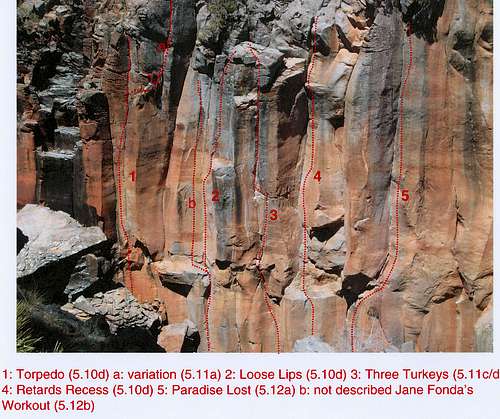
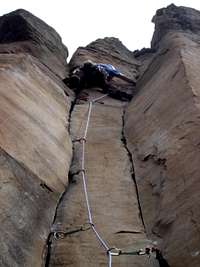


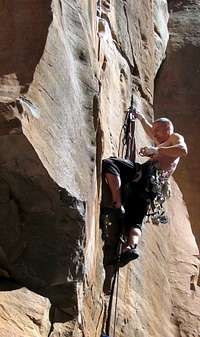
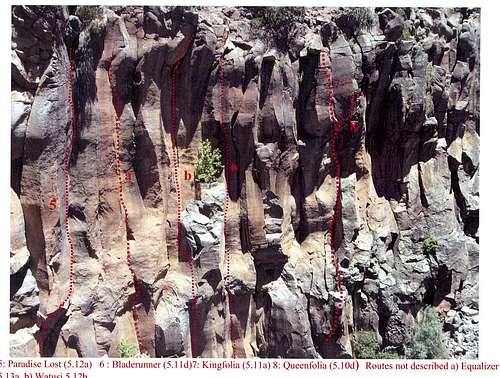
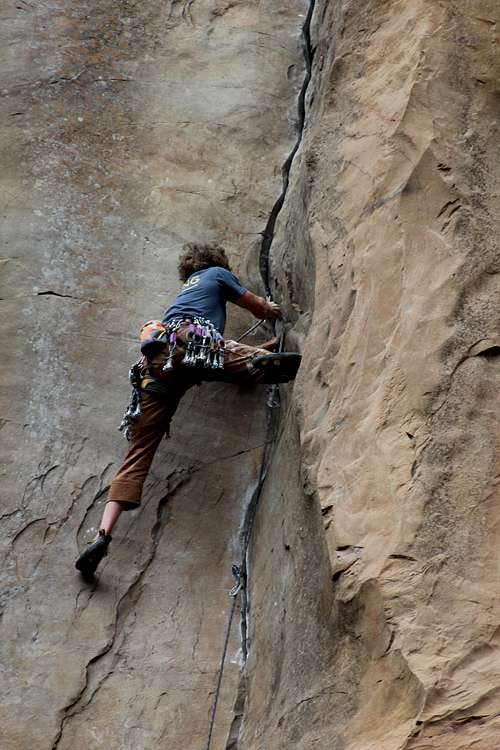




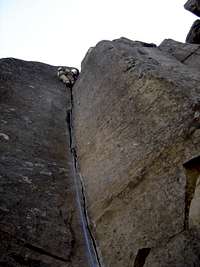
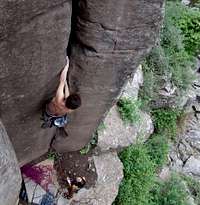
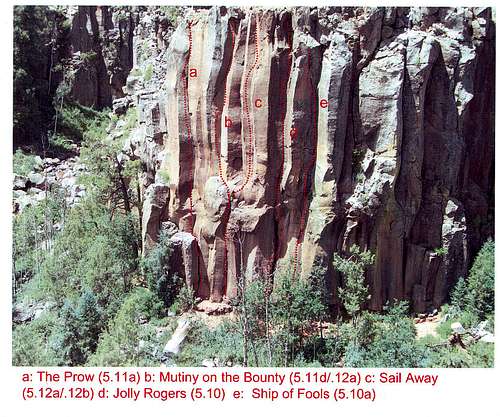
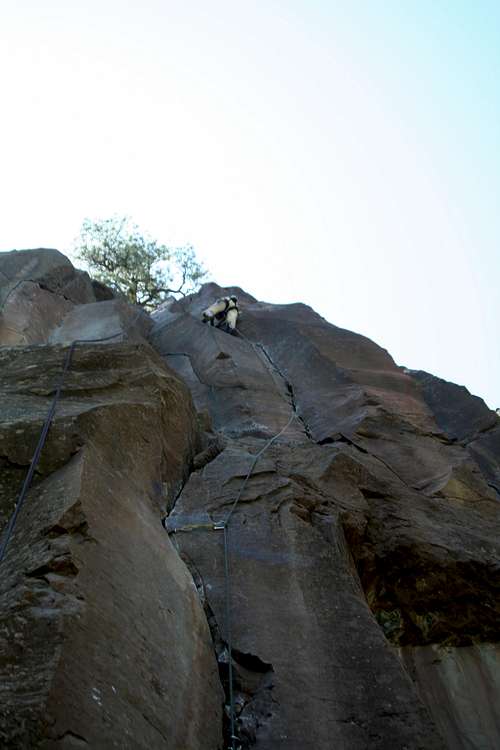
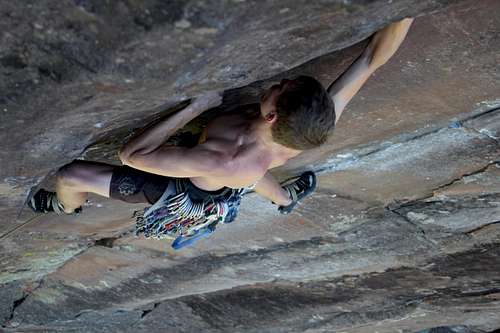

Eleutheros - Jun 15, 2007 11:53 pm - Voted 8/10
CoordinatesYou have incorrect coordinates. You might want to change them. Thanks! -E
CClaude - Jun 19, 2007 5:24 pm - Hasn't voted
Thanks... nrow correctedIn te text the GPS coodinates were correct. I was lazy and didn't change the coordinates on the google map. This has been changed and where you know see as the pin, is where I always park my car (about 20m from the bathroom)and about 200m from gold and silver canyons